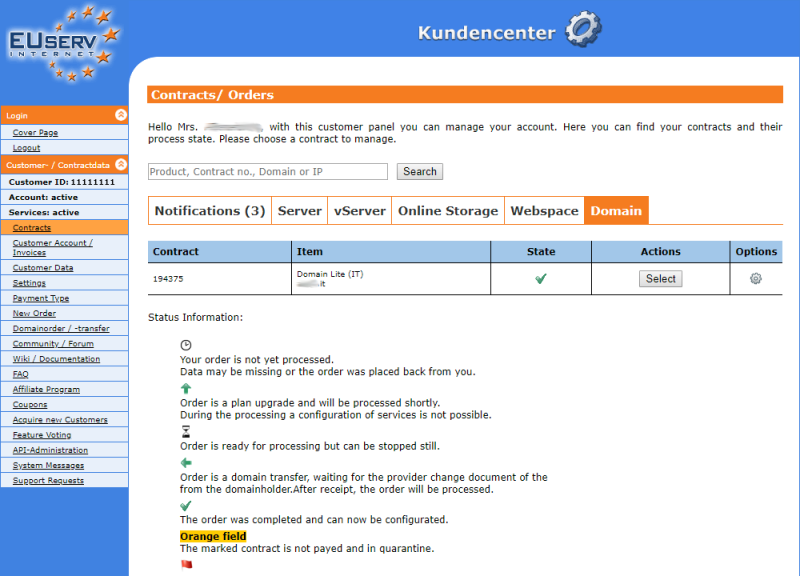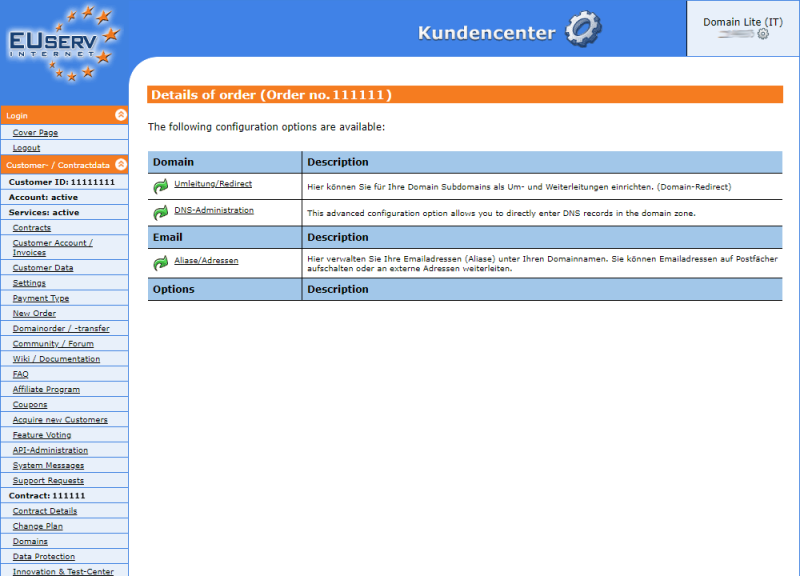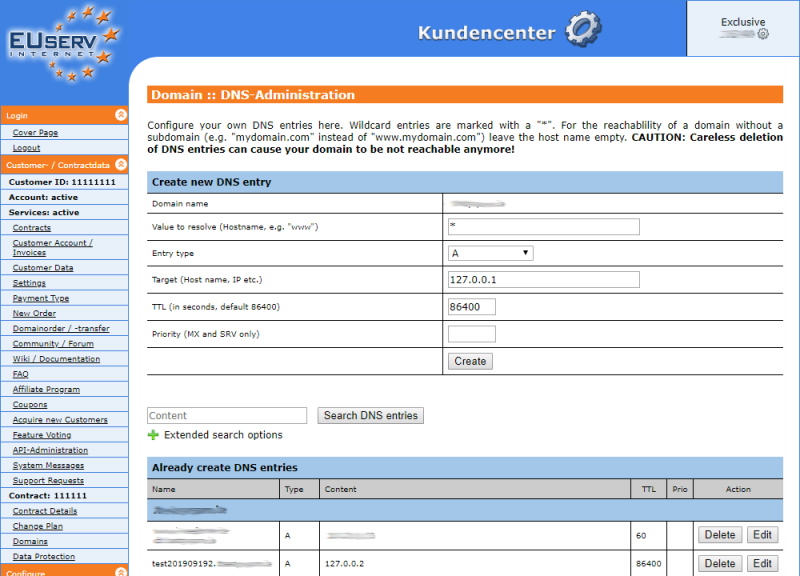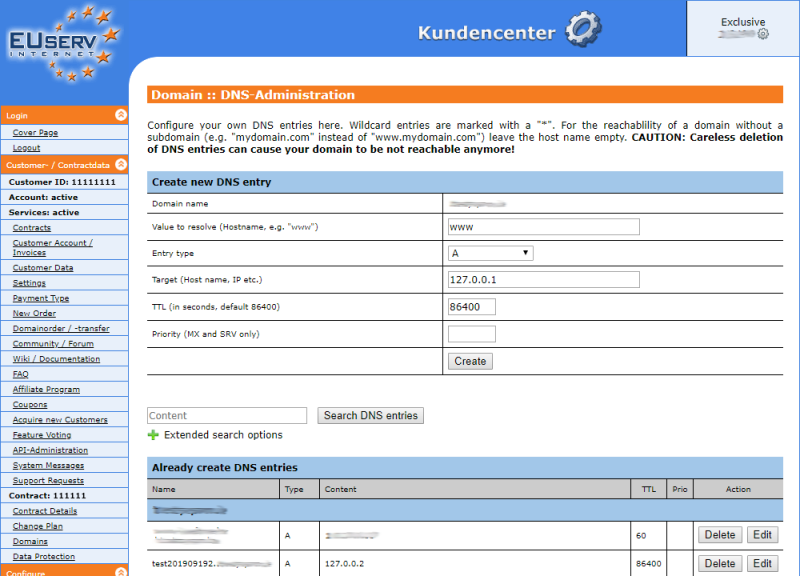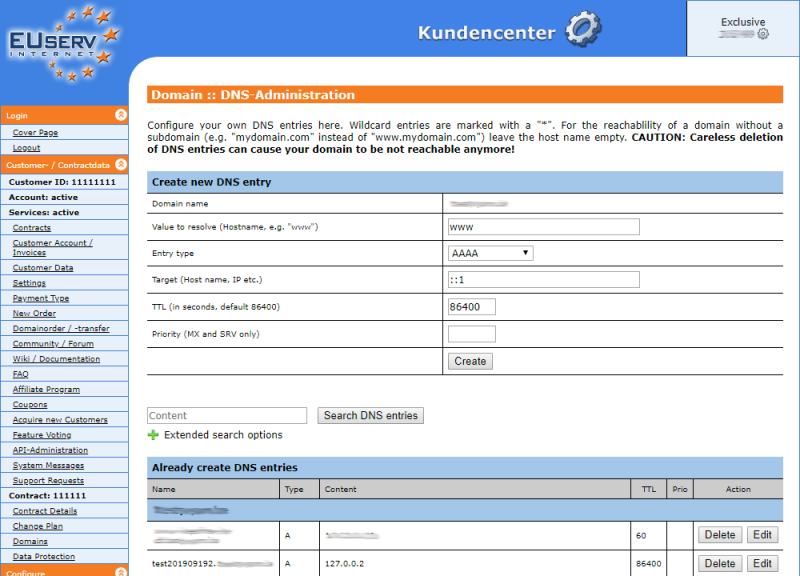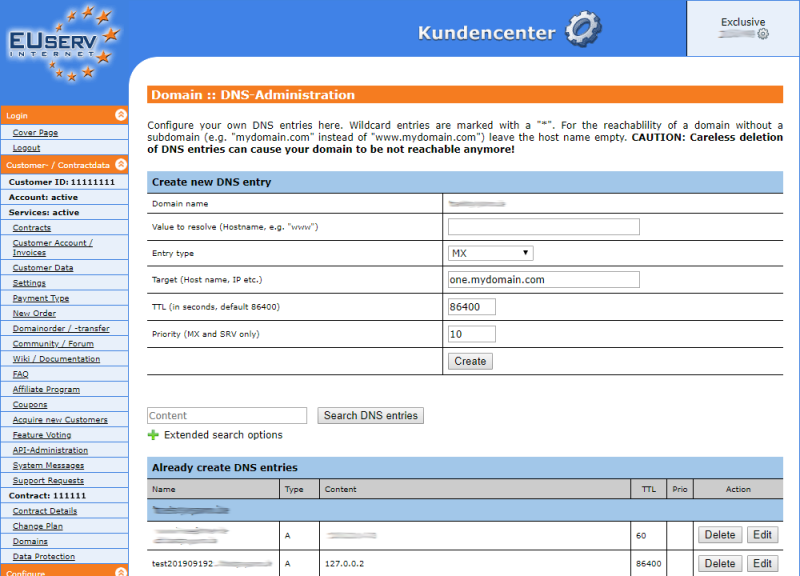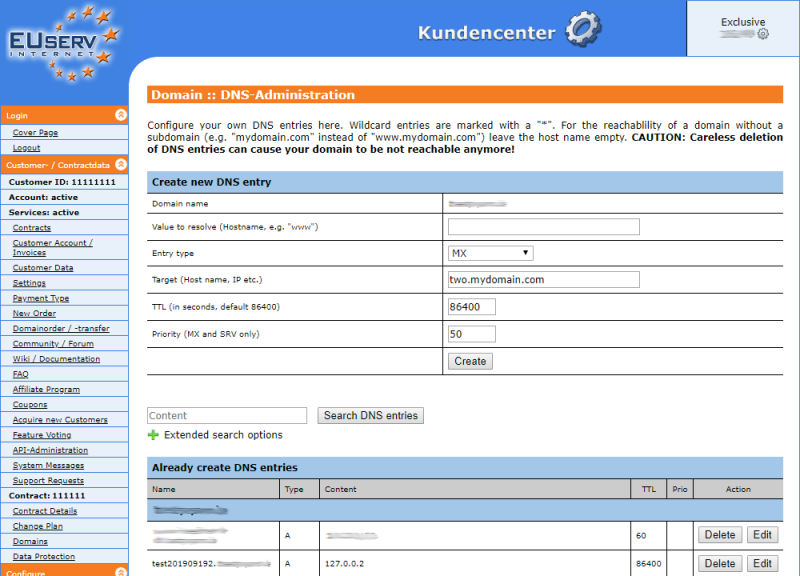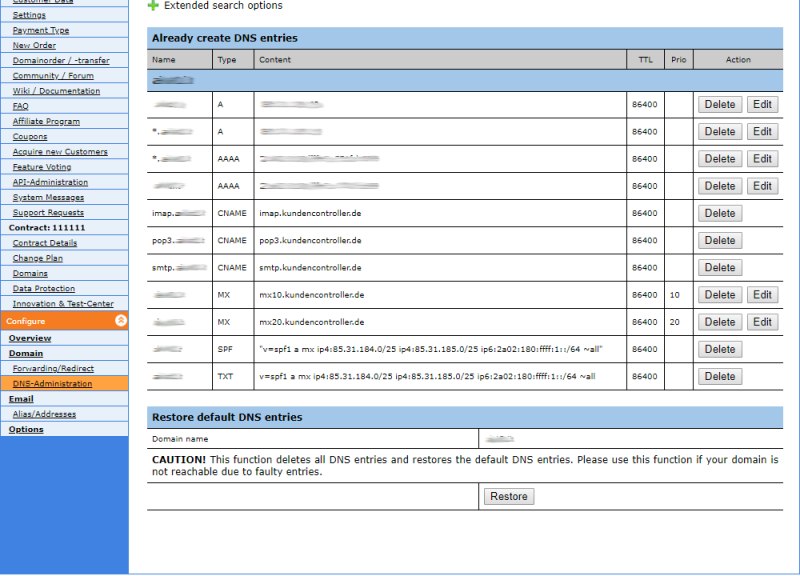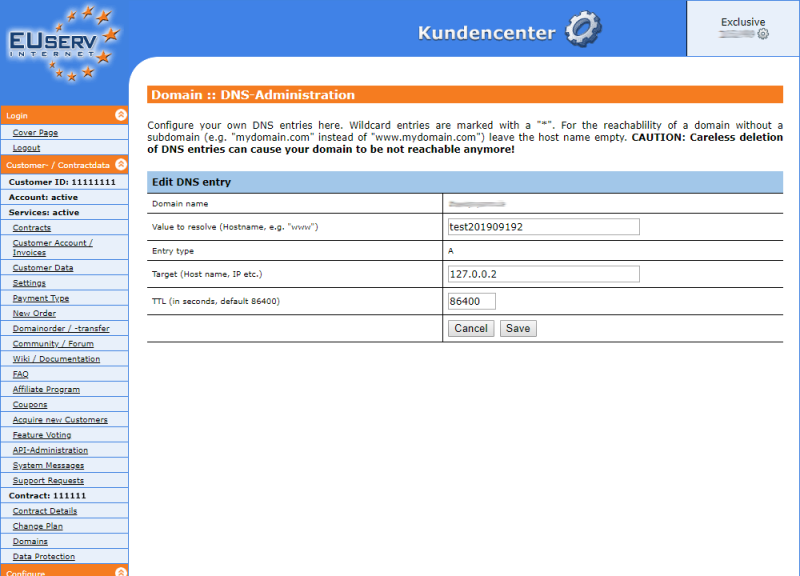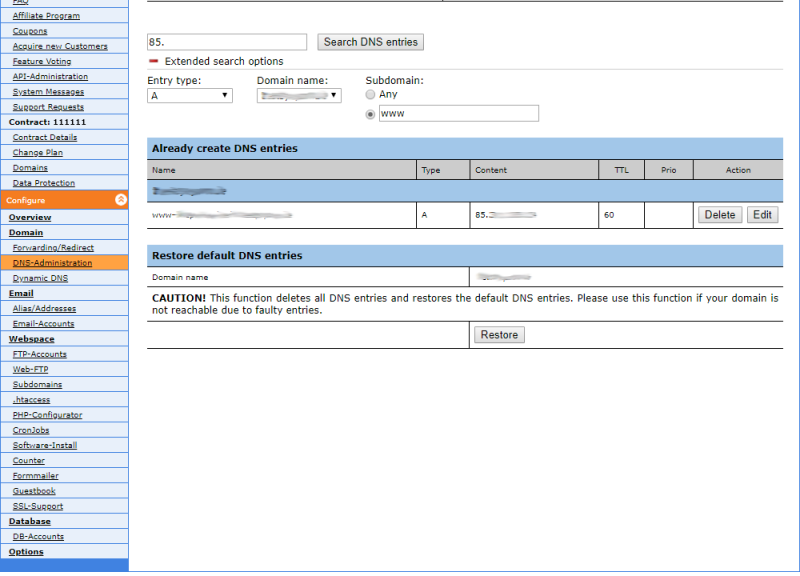Kundencenter DNS Records/en
Aus EUserv Wiki
(→Creating AAAA-Record) |
Seki1 (Diskussion | Beiträge) (→Search DNS records) |
||
| (Der Versionsvergleich bezieht 41 dazwischenliegende Versionen mit ein.) | |||
| Zeile 2: | Zeile 2: | ||
[[Kategorie:Customer center Domain]] | [[Kategorie:Customer center Domain]] | ||
[[Kategorie:DNS/en]] | [[Kategorie:DNS/en]] | ||
| - | '''''Create DNS | + | '''''Create DNS records''''' |
__TOC__ | __TOC__ | ||
<div style= "font-size: 1.571em;"> | <div style= "font-size: 1.571em;"> | ||
| - | '''Creating DNS | + | '''Creating DNS records''' |
</div> | </div> | ||
== General == | == General == | ||
| Zeile 11: | Zeile 11: | ||
It's main task is to respond to requests for name resolution. | It's main task is to respond to requests for name resolution. | ||
| - | In analogy to request the contact information to the DNS from a host name (the name of a machine noticeable for people on the internet) for example www.example.org, as a response for the associated IP address (the "Port Number" on the Internet) for example, an IPv4 address like to call 192.12.0.10 or an IPv6 address as 2001: db7: 83d3: 8d1: 1329: | + | In analogy to request the contact information to the DNS from a host name (the name of a machine noticeable for people on the internet) for example www.example.org, as a response for the associated IP address (the "Port Number" on the Internet) for example, an IPv4 address like to call 192.12.0.10 or an IPv6 address as 2001:db7:83d3:8d1:1329:8a2f:073:4773 |
| - | == Creating DNS | + | == Creating DNS record == |
| - | In the EUserv customer | + | In the EUserv customer panel you have the possibility to create the different types of DNS records. |
| + | |||
| + | Proceed as follows: <br><br> | ||
| + | |||
| + | 1. Log in to customer panel. | ||
| + | <br><br> | ||
| + | 2. Click in the left menu in the section <b>Customer- / Contractdata</b> the menue item <b>Contracts</b>. | ||
| + | <br><br> | ||
| + | 3. Then click on the tab for the desired product group (for example, <b>Domain</b> or <b>Webspace</b>). Now select your contract containing at least one domain by clicking on <b>Select</b>.<br><br> | ||
| - | |||
| - | |||
| - | |||
<center> | <center> | ||
| - | [[Datei: | + | [[Datei:Kc2_select_contract_domain_en.png|800px]] |
</center> | </center> | ||
<br> | <br> | ||
| - | Once you have selected your domain contract, now click | + | 4. Once you have selected your domain contract, now click <b>DNS-Administration</b>. |
<br> | <br> | ||
<br> | <br> | ||
<center> | <center> | ||
| - | [[Datei: | + | [[Datei:Kc2_domain_config_en.png|800px]] |
</center> | </center> | ||
<br> | <br> | ||
| Zeile 35: | Zeile 40: | ||
=== Creating A-Record === | === Creating A-Record === | ||
| - | + | Here you can create the DNS record. Make sure that in <b>Domain name</b> the desired domain is displayed. | |
| - | In | + | In <b>Value to resolve (Hostname, e.g. "www")</b> enter the desired value. A <b>*</b> stands for a wildcard entry, which means that all inputs before your domain (e.g. xyz.mydomain.com) are redirected to the IPv4 address that you have specified. In this example we use the IPv4 address 127.0.0.1 (note: the IPv4 address 127.0.0.1 does not work, its the local host address of each computer and is used here only as an example). If you enter xyz.mydomain.com you will reach the corresponding server (mydomain.de) of the IPv4 address 127.0.0.1. Thus we can ensure that the visitor will be redirected to the server that you have defined for 127.0.0.1 (e.g. for landing pages). |
| - | Enter in this field | + | Enter the known <b>www</b> in this field so visitors who enter www.mydomain.com will be redirected to the defined server of www.mydomain.com. However should a visitor ommit the <b>www</b> he will not reach your server and land on an error page. |
| - | In | + | In <b>Target (Host name, IP etc.)</b> you must enter the desired IPv4 address that you want the domain to forward to for example 127.0.0.1. |
| - | + | <b>TTL (in seconds, default 86400)</b> is automatically set to 86400 and <b>Priority (MX and SRV only)</b> are not required for A records and you don't have to make any inputs. | |
| - | Your customer | + | Your customer panel should look like this now: |
<br> | <br> | ||
<br> | <br> | ||
<center> | <center> | ||
| - | [[Datei: | + | [[Datei:Kc2_domain_dns_management_create_a_record_wildcard_en.png|800px]] |
</center> | </center> | ||
<br> | <br> | ||
| Zeile 57: | Zeile 62: | ||
<br> | <br> | ||
<center> | <center> | ||
| - | [[Datei: | + | [[Datei:Kc2_domain_dns_management_create_a_record_www_en.png|800px]] |
</center> | </center> | ||
| - | Click | + | Click on <b>Create</b> after you entered a record to save your input. |
<br> | <br> | ||
<br> | <br> | ||
| + | |||
| + | '''Please note: If you use DNS entries of type AAAA (IPv6 addresses), you must delete or edit these entries.''' | ||
=== Creating AAAA-Record === | === Creating AAAA-Record === | ||
| - | As the Internet grows world wide | + | As the Internet grows faster world wide more and more IPv4 addresses are needed but only limited quantities are available. So the IPv6 successor was created. |
| - | + | To redirect to an IPv6 address an additional record is required since the A-standard does not work anymore here. For this reason AAAA records are used. | |
| - | The AAAA record has the same function as an A record | + | The AAAA record has the same function as an A record but for forwarding to an IPv6 addresses. For an AAAA record please enter your data analogous to an A record. |
<br> | <br> | ||
<br> | <br> | ||
<center> | <center> | ||
| - | [[Datei: | + | [[Datei:Kc2_domain_dns_management_create_aaaa_record_www_en.png|800px]] |
</center> | </center> | ||
<br> | <br> | ||
<br> | <br> | ||
| - | === Creating MX | + | === Creating MX record === |
| - | An MX record is responsible for the information | + | An MX record is responsible for the information with which address a mail server of a domain or subdomain is accessible (MX= Mail Exchange). |
| - | + | Thus, emails for your domain can reach your mail server. In case of a malfunction or a wrong subdomain in the mail address it is recommended to specify multiple MX records with different priorities. | |
| - | With the MX record | + | With the MX record you can define where the messages are routed, so that different subdomains are also possible (mail@mydomain.com - the part after the @ is specified by the MX record). |
| - | A mail server | + | A mail server that sends an email to your domain checks the MX record with the lowest priority (e.g. one.mydomain.com, priority 10) first. If this server is not reachable other MX records are checked (e.g. two.mydomain.com, priority 50). |
| + | This means an email that could not be send to the first mail server is send to the second mail server. The email is not lost. | ||
| - | Please note that | + | Please note that you must specify a domain because at MX records can not be used with IP addresses and any wildcards ("*")! |
<br> | <br> | ||
<br> | <br> | ||
<center> | <center> | ||
| - | [[Datei: | + | [[Datei:Kc2_domain_dns_management_create_mx_record_one_en.png|800px]] |
</center> | </center> | ||
<br> | <br> | ||
<br> | <br> | ||
<center> | <center> | ||
| - | [[Datei: | + | [[Datei:Kc2_domain_dns_management_create_mx_record_two_en.png|800px]] |
</center> | </center> | ||
<br> | <br> | ||
<br> | <br> | ||
| - | === Restore | + | === Restore defaults === |
| - | + | If you have created a DNS record that does not produce the desired outcome or if your domain is not reachable you can reset the DNS records in the customer panel. | |
| - | + | At the very bottom of the page below <b>Restore default DNS entries</b> click on <b>Restore</b>. | |
<br> | <br> | ||
<br> | <br> | ||
<center> | <center> | ||
| - | [[Datei: | + | [[Datei:Kc2_domain_dns_management_reset_en.png|800px]] |
</center> | </center> | ||
<br> | <br> | ||
<br> | <br> | ||
| + | |||
| + | == Editing DNS record == | ||
| + | |||
| + | In the EUserv customer panel you have the possibility to edit DNS records. | ||
| + | |||
| + | Proceed as follows: <br><br> | ||
| + | |||
| + | 1. In the lower table where the DNS records are listed click on <b>Edit</b> next to the DNS record you want to change. | ||
| + | |||
| + | |||
| + | PLEASE NOTE: If the <b>Edit</b> button is not shown than this function is not available within the selected plan for this DNS type. This can occur for example with DNS records that are created with a default value. | ||
| + | |||
| + | <center> | ||
| + | [[Datei:Kc2_domain_dns_management_reset_en.png|800px]] | ||
| + | </center> | ||
| + | <br> | ||
| + | 2. Make your desired changes and confirm your input with a click on <b>Save</b>. Note that the type cannot be changed. To change the type please create a new record. | ||
| + | <br> | ||
| + | <br> | ||
| + | <center> | ||
| + | [[Datei:Kc2_domain_dns_management_edit_en.png|800px]] | ||
| + | </center> | ||
| + | |||
| + | |||
| + | == Search DNS records == | ||
| + | In the EUserv customer panel you have the possibility to search for DNS records. This is especially useful if you manage a lot of DNS records for a domain or if you have a lot of additional domains in your contract. | ||
| + | |||
| + | In the search field left to the button <b>Search DNS entries</b> you can enter the <b>Content</b> or parts of the content that you want to search for (e.g. an IP address). | ||
| + | |||
| + | Click on <b>Extended search options</b> to show the following additional search options: | ||
| + | |||
| + | * <b>Entry type</b> - Search for entries with a specific record type | ||
| + | * <b>Domain name</b> - Search for entries of a specific domain (useful if you have more than one domain in a contract) | ||
| + | * <b>Subdomain</b> - Search for entries with a specific subdomain or parts of a subdomain (e.g. www); select the subdomain field and leave it empty to search for the main domain (without subdomain) only | ||
| + | |||
| + | When you have entered the desired search parameters click on <b>Search DNS entries</b>. | ||
| + | |||
| + | |||
| + | <center> | ||
| + | [[Datei:Kc2_domain_dns_management_search_records_en.png|800px]] | ||
| + | </center> | ||
Aktuelle Version vom 12:22, 25. Sep. 2019
| | Languages: |
Deutsch |
Create DNS records
Inhaltsverzeichnis |
Creating DNS records
General
The Domain Name System (DNS) is one of the most important services in the IT network. It's main task is to respond to requests for name resolution.
In analogy to request the contact information to the DNS from a host name (the name of a machine noticeable for people on the internet) for example www.example.org, as a response for the associated IP address (the "Port Number" on the Internet) for example, an IPv4 address like to call 192.12.0.10 or an IPv6 address as 2001:db7:83d3:8d1:1329:8a2f:073:4773
Creating DNS record
In the EUserv customer panel you have the possibility to create the different types of DNS records.
Proceed as follows:
1. Log in to customer panel.
2. Click in the left menu in the section Customer- / Contractdata the menue item Contracts.
3. Then click on the tab for the desired product group (for example, Domain or Webspace). Now select your contract containing at least one domain by clicking on Select.
4. Once you have selected your domain contract, now click DNS-Administration.
Creating A-Record
Here you can create the DNS record. Make sure that in Domain name the desired domain is displayed.
In Value to resolve (Hostname, e.g. "www") enter the desired value. A * stands for a wildcard entry, which means that all inputs before your domain (e.g. xyz.mydomain.com) are redirected to the IPv4 address that you have specified. In this example we use the IPv4 address 127.0.0.1 (note: the IPv4 address 127.0.0.1 does not work, its the local host address of each computer and is used here only as an example). If you enter xyz.mydomain.com you will reach the corresponding server (mydomain.de) of the IPv4 address 127.0.0.1. Thus we can ensure that the visitor will be redirected to the server that you have defined for 127.0.0.1 (e.g. for landing pages).
Enter the known www in this field so visitors who enter www.mydomain.com will be redirected to the defined server of www.mydomain.com. However should a visitor ommit the www he will not reach your server and land on an error page.
In Target (Host name, IP etc.) you must enter the desired IPv4 address that you want the domain to forward to for example 127.0.0.1.
TTL (in seconds, default 86400) is automatically set to 86400 and Priority (MX and SRV only) are not required for A records and you don't have to make any inputs.
Your customer panel should look like this now:
or so:
Click on Create after you entered a record to save your input.
Please note: If you use DNS entries of type AAAA (IPv6 addresses), you must delete or edit these entries.
Creating AAAA-Record
As the Internet grows faster world wide more and more IPv4 addresses are needed but only limited quantities are available. So the IPv6 successor was created.
To redirect to an IPv6 address an additional record is required since the A-standard does not work anymore here. For this reason AAAA records are used.
The AAAA record has the same function as an A record but for forwarding to an IPv6 addresses. For an AAAA record please enter your data analogous to an A record.
Creating MX record
An MX record is responsible for the information with which address a mail server of a domain or subdomain is accessible (MX= Mail Exchange).
Thus, emails for your domain can reach your mail server. In case of a malfunction or a wrong subdomain in the mail address it is recommended to specify multiple MX records with different priorities.
With the MX record you can define where the messages are routed, so that different subdomains are also possible (mail@mydomain.com - the part after the @ is specified by the MX record).
A mail server that sends an email to your domain checks the MX record with the lowest priority (e.g. one.mydomain.com, priority 10) first. If this server is not reachable other MX records are checked (e.g. two.mydomain.com, priority 50). This means an email that could not be send to the first mail server is send to the second mail server. The email is not lost.
Please note that you must specify a domain because at MX records can not be used with IP addresses and any wildcards ("*")!
Restore defaults
If you have created a DNS record that does not produce the desired outcome or if your domain is not reachable you can reset the DNS records in the customer panel.
At the very bottom of the page below Restore default DNS entries click on Restore.
Editing DNS record
In the EUserv customer panel you have the possibility to edit DNS records.
Proceed as follows:
1. In the lower table where the DNS records are listed click on Edit next to the DNS record you want to change.
PLEASE NOTE: If the Edit button is not shown than this function is not available within the selected plan for this DNS type. This can occur for example with DNS records that are created with a default value.
2. Make your desired changes and confirm your input with a click on Save. Note that the type cannot be changed. To change the type please create a new record.
Search DNS records
In the EUserv customer panel you have the possibility to search for DNS records. This is especially useful if you manage a lot of DNS records for a domain or if you have a lot of additional domains in your contract.
In the search field left to the button Search DNS entries you can enter the Content or parts of the content that you want to search for (e.g. an IP address).
Click on Extended search options to show the following additional search options:
- Entry type - Search for entries with a specific record type
- Domain name - Search for entries of a specific domain (useful if you have more than one domain in a contract)
- Subdomain - Search for entries with a specific subdomain or parts of a subdomain (e.g. www); select the subdomain field and leave it empty to search for the main domain (without subdomain) only
When you have entered the desired search parameters click on Search DNS entries.

